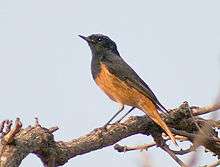Phoenicurus
| Phoenicurus | |
|---|---|
 | |
| Phoenicurus ochruros | |
| Scientific classification | |
| Kingdom: | Animalia |
| Phylum: | Chordata |
| Class: | Aves |
| Order: | Passeriformes |
| Family: | Muscicapidae |
| Genus: | Phoenicurus T. Forster, 1817 |
Phoenicurus is a genus of passerine birds in the Old World flycatcher family Muscicapidae, native to Europe, Asia and Africa. Along with three other closely related genera, they are named redstarts from their orange-red tails ('start' is an old name for a tail). They are small insectivores, the males mostly brightly coloured in various combinations of red, blue, white, and black, the females light brown with a red tail.[1] A molecular phylogenetic study published in 2010 led to a reorganization of the Old World flycatchers family in which the two species in Rhyacornis and the single species in Chaimarrornis were merged into Phoenicurus.[2][3]
The genus name Phoenicurus is from Ancient Greek phoinix, "red", and -ouros -"tailed".[4]
The genus contains the following species:[3]
- Przevalski's redstart (Phoenicurus alaschanicus)
- Eversmann's redstart (Phoenicurus erythronotus)
- Blue-capped redstart (Phoenicurus caeruleocephala)
- Black redstart (Phoenicurus ochruros)
- Common redstart (Phoenicurus phoenicurus)
- Hodgson's redstart (Phoenicurus hodgsoni)
- White-throated redstart (Phoenicurus schisticeps)
- Daurian redstart (Phoenicurus auroreus)
- Moussier's redstart (Phoenicurus moussieri)
- Güldenstädt's redstart (Phoenicurus erythrogastrus)
- Blue-fronted redstart (Phoenicurus frontalis)
- Plumbeous water redstart (Phoenicurus fuliginosus) (previously in the genus Rhyacornis)
- Luzon water redstart (Phoenicurus bicolor) (previously in the genus Rhyacornis)
- White-capped redstart (Phoenicurus leucocephalus) (previously in the monotypic genus Chaimarrornis)
Fossil record
Phoenicurus erikai (Pliocene of Csarnota, Hungary).[5] Phoenicurus baranensis (Pliocene of Beremend, Hungary).[5]
References
- ↑ Hoyo, J. del, et al., eds. (2005). Handbook of the Birds of the World, vol. 10. Barcelona: Lynx Edicions. pp. 768–773. ISBN 84-87334-72-5.
- ↑ Sangster, G.; Alström, P.; Forsmark, E.; Olsson, U. (2010). "Multi-locus phylogenetic analysis of Old World chats and flycatchers reveals extensive paraphyly at family, subfamily and genus level (Aves: Muscicapidae)". Molecular Phylogenetics and Evolution. 57 (1): 380–392. doi:10.1016/j.ympev.2010.07.008.
- 1 2 Gill, Frank; Donsker, David (eds.). "Chats, Old World flycatchers". World Bird List Version 6.2. International Ornithologists' Union. Retrieved 20 May 2016.
- ↑ Jobling, James A. (2010). The Helm Dictionary of Scientific Bird Names. London, United Kingdom: Christopher Helm. p. 304. ISBN 978-1-4081-2501-4..
- 1 2 Kessler, E. 2013. Neogene songbirds (Aves, Passeriformes) from Hungary. – Hantkeniana, Budapest, 2013, 8: 37-149.